The back yard is a bit of a funny shape too. While it is 23 metres wide, the southern boundary is ten metres long but the yard opens out towards the north so that the northern boundary is 17 metres long, giving the yard a sort of trapezium shape with an area of about 300 square metres.
The Veggie Plots
There are 15 veggie plots all up and most of them are 2 metres by 1.2 metres -
• there are two sets of three against the southern fence, the southern most set of three having a fixed trellis set up along the southern fence.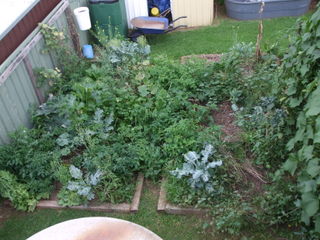
• three long(3metre) ones in front of the choko tree/potato cages, 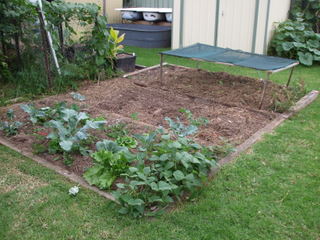
• four against the western fence which also have a fixed trellis on the fence, and 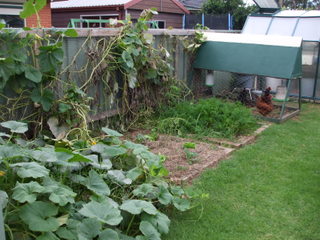
• two against the northern fence although these are really only usable in late spring, summer and early autumn due to shading.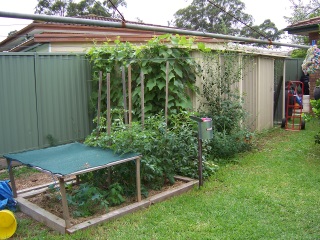
While it is nice to have all plots up and firing, full of wonderfully productive vegetables at the right time of the year, or continual rotation of beds and 12 month cycle of food production means that at any time of the year you will see –
- Plots mulched and ready to be planted out
- Plots with veggies growing at various stages
- Plots with mature veggies about to be or being harvested
- Plots past their prime ready to have the chook tractor on them to clear them out, and
- One with the chook tractor in place.
The chook Tractor
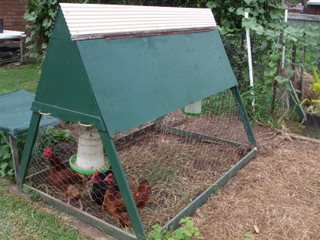
This is a moveable A-frame chook shed that has no bottom so when it is moved onto a newly harvested veggie bed they go berserk, wreaking havoc on the remaining pests (like snails) and weeds or past their prime veggies that remain in the plot. The tractor has the same footprint as most of the veggie beds. The chooks do enjoy their job, particularly when getting onto anew plot, they rip the living daylights out of it and reduce it to a desert (albeit a fertile one) by scratching up and digging in the remaining vegetation as well as manuring it. They spend two weeks on each plot and when they have finished it just remains to remove any root systems still in place, smooth out the surface, apply the mulch and replant when the seedlings become available. So they do all the hard work and on top of it all produce eggs, it works for me. We have had up to half a dozen chooks in the tractor but at the moment we have two Rhode Island reds and one Australorp, but we are currently breeding up some replacement layers.
The Greenhouse
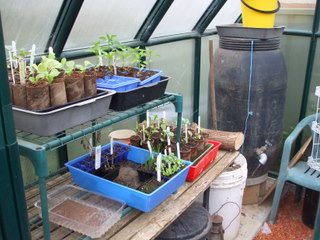
This started out as a steel-tube-and-plastic-joiner cheapie about 2 metres wide by 3 metres long bought for about $150 and covered with translucent green plastic to see how it would work out. The original plastic outer hardly lasted the first season before it started to fall apart so I replaced it with proper green house plastic and built a real door and back window. That lasted 5 years or more but the UV radiation got to be too much for the plastic joiners and the whole thing started to collapse even though the plastic cover still had plenty of life in it, but it had proven its usefulness so I needed to replace rather than scrap it. A genuine glass glasshouse was over $5000 at the time and I could not afford it, but we compromised with a Rion brand polycarbonate glasshouse for $1300. That was four years ago and it is still going strong. 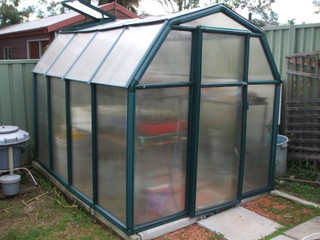
The greenhouse is a great place to work on a winters’ sunny day and I use it to raise seedlings, do a bit of out-of-season growing, plant propagation and holding all my bulk garden needs like sand, wood ash, cocopeat and blood & bone as well as our pot, punnet and tray supplies. It also holds a black drum of liquid manure that doubles as a heat store in winter and it is great for drying wood and clay and sterilising compost in the summer when it gets too hot to grow the seedlings.
The Retirement Village
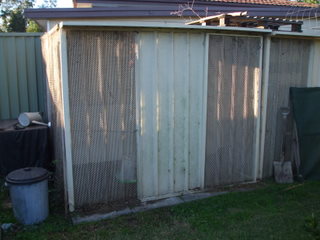
The chooks in the chook tractor get too old to lay after a few years and need to be replaced with fresh chooks, so what to do with them? The obvious answer is “eat them!” but to date we have not travelled that route. We do have a well ventilated shed that is kept on deep litter principles which is where these chooks end up, they become our mulch processing unit. I get local grass hay and then put it in the retirement village and the chooks dig it over and break it down, eat the weed seeds, manure it and generally turn it into great mulch. I draw from it as I need it and when the level gets a bit low I just toss in another bale. We do get the occasional egg but they are doing good work making the mulch for me and that lets them earn their keep. The retirement village and the worm shed are at the northern end of the yard, so that the area is productive even if it gets too much shade to grow food for most of the year.
The Worm shed
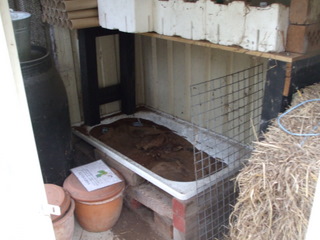
When we make our own seed raising/potting mix one of the key ingredients is worm castings so we needed a nice big wormery to take care of our veggie waste, treat the stuff that comes out of the home made bokashi bin and provide loooooots of castings. I converted an old bath to a worm farm and it works pretty well, a blow-by-blow account of how I did it is in the “Livestock” section of the site. It gets damn hot out here in summer so the wormery also needed to be protected from the elements so I built it in the second shed. This shed also provides storage for the straw bales for mulch, a set up for growing mushrooms which is not in use at the moment and the pot in pot coolers (out of the sun but good ventilation).



